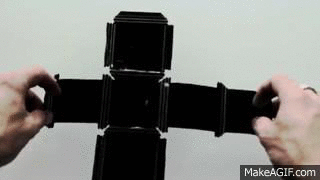 Massachusetts Institute of Technology is widely considered the epicenter of the world’s technological innovation, and nothing is more on the forefront of the future than the MIT Media Lab. At events all over the world MIT’s Technology Review tries to start global conversations about technologies that matter, the people who make them and how they could change our lives. Throughout 2015 the chosen topics were as diverse as they were cutting edge, including Augmented Knowledge, Better Living Through Data, Infinite Energy, Rethinking Urban Infrastructure, and Robots Among Us. At last week’s MIT’s Technology Review EmTech Brazil, audiences got a taste of what the future of wearable technology and self-assembling consumer products could be.
Massachusetts Institute of Technology is widely considered the epicenter of the world’s technological innovation, and nothing is more on the forefront of the future than the MIT Media Lab. At events all over the world MIT’s Technology Review tries to start global conversations about technologies that matter, the people who make them and how they could change our lives. Throughout 2015 the chosen topics were as diverse as they were cutting edge, including Augmented Knowledge, Better Living Through Data, Infinite Energy, Rethinking Urban Infrastructure, and Robots Among Us. At last week’s MIT’s Technology Review EmTech Brazil, audiences got a taste of what the future of wearable technology and self-assembling consumer products could be.
As a researcher of fluid interfaces from the Media Lab, Marcelo Coelho sees the future full of clothing and wearable devices that are smarter than us, and better at finding information for us than we ever would be going it alone. Or perhaps our wearable technology will simply be adaptable to any situation that we find ourselves in, such as a shirt that has a hemline that will rise and fall depending on the event being attended. Or even a dress that has flowers that open and close based on the time of day, temperature or even the humidity.
“You can program your shirt for it to change colour, or move to a different pattern. Maybe you’re at work today and want your shirt one way, but you’ll be at a party tonight and want it different,” explained Coelho to an audience at EmTech.
 But Coelho wasn’t just talking about smart fashion that was aesthetically adaptable, he also sees a future where wearable technology actually guides us to the people that we are looking for. He started by showing off a device that would interface with your social media platforms and in a crowd or party scenario actually guide you to people who have similar interests as you. The device that Coelho showed off looked like a simple watch, but it did far more than tell time, it actually searches everyone else in the room wearing a similar device and notifies you when it found someone who you should talk to, or someone that you should avoid by glowing green or red.
But Coelho wasn’t just talking about smart fashion that was aesthetically adaptable, he also sees a future where wearable technology actually guides us to the people that we are looking for. He started by showing off a device that would interface with your social media platforms and in a crowd or party scenario actually guide you to people who have similar interests as you. The device that Coelho showed off looked like a simple watch, but it did far more than tell time, it actually searches everyone else in the room wearing a similar device and notifies you when it found someone who you should talk to, or someone that you should avoid by glowing green or red.
Here is some video about the device, called Alike:
Another speaker at the event in Rio de Janeiro was MIT scientist Skylar Tibbits who many regard as the father of 4D self-assembly technology. He spoke to the audience about how the 4D technology that he is working on can change our relationship to the products that we buy and use. Say for instance, that you purchased some new furniture, and instead of opening up a box, getting out some tools and assembling all of the parts the furniture would simply put itself together.
Not with robotics or magic, but because it was designed to be packed and shipped flat, however it is programed with 4D technology to pull itself into the desired shape once it was removed from the shipping container. Or what about car tires that alter their shape and tread based on the type of road the car is being driven on, what the weather conditions are or even how fast the car is moving? This may sound like the stuff of science fiction, but haven’t we learned by now that most science fiction is just science fact that we’re still perfecting?
4D technology is similar to soft robotics in the sense that it requires no power, no computers or no manual intervention to work. But instead the materials themselves are programmed, and manufactured, in such a way that they alter themselves based on external stimulation, be it an exposure to oxygen, water, heat or even the time of day. If the materials, which already exist today, are combined in certain combinations then they can literally pull themselves together or perform complex actions all on their own.
The eventual next step of course is augmenting the body itself with technology by implanting small devices that connect us to the growing flow of data like never before. Internal wifi connectivity would allow constant monitoring of a person’s body. Imagine removing the amount of cords attached to the body as hospitals without losing the ability to monitor a patient’s vitals, or being able to just think about unlocking a door or turning on a light.
Subscribe to Our Email Newsletter
Stay up-to-date on all the latest news from the 3D printing industry and receive information and offers from third party vendors.
You May Also Like
3D Printing News Briefs, April 13, 2024: Robotics, Orthotics, & Hypersonics
In 3D Printing News Briefs today, we’re focusing first on robotics, as Carnegie Mellon University’s new Robotics Innovation Center will house several community outreach programs, and Ugogo3D is now working...
Rail Giant Alstom Saves $15M with 3D Printing Automation Software 3D Spark
3D Spark has entered into a three-year deal with the rail giant Alstom. Alstom, a transport behemoth with annual revenues of $16 billion, specializes in the manufacture of trains, trams,...
Meltio Expands Global Reach with New Partnerships in the Americas and Europe
Spanish 3D printing manufacturer Meltio has expanded its sales network across the globe. With the addition of three new partners in the United States, Brazil, Argentina, and Italy, Meltio aims...
3D Printing Webinar and Event Roundup: April 7, 2024
Webinars and events in the 3D printing industry are picking back up this week! Sea-Air-Space is coming to Maryland, and SAE International is sponsoring a 3D Systems webinar about 3D...

































